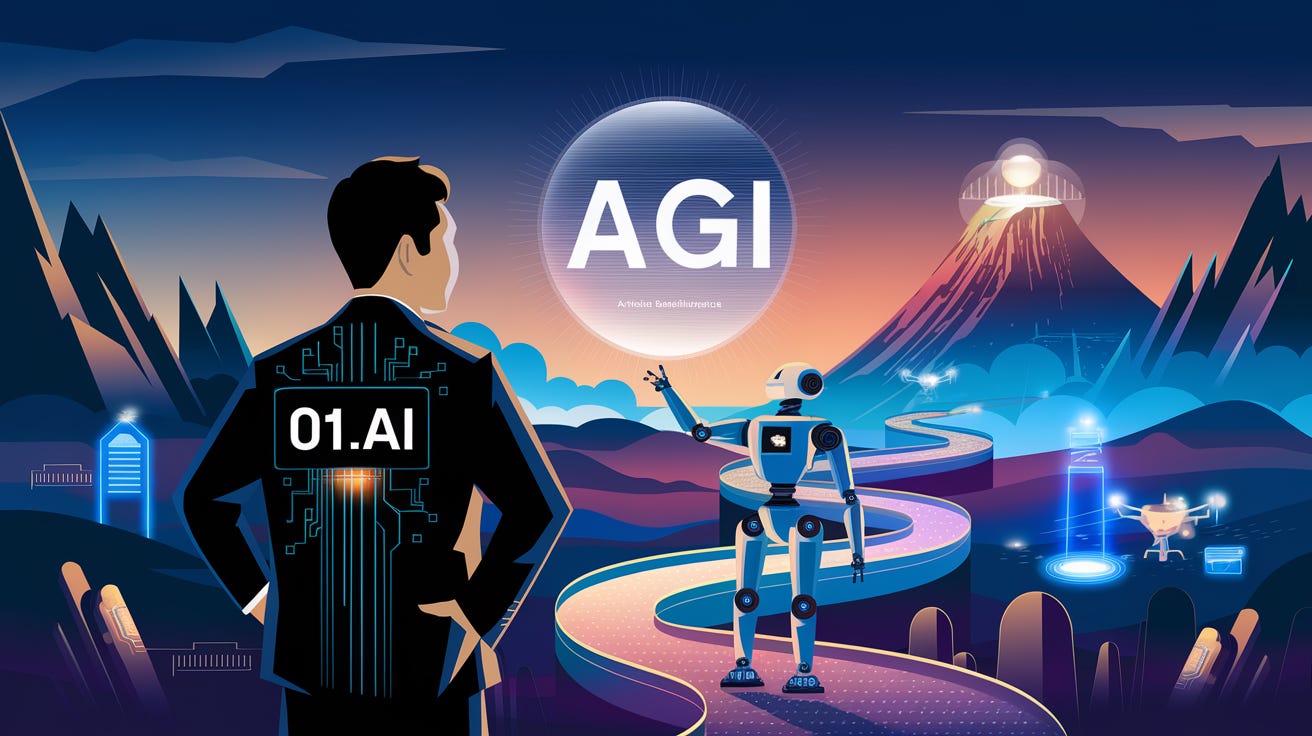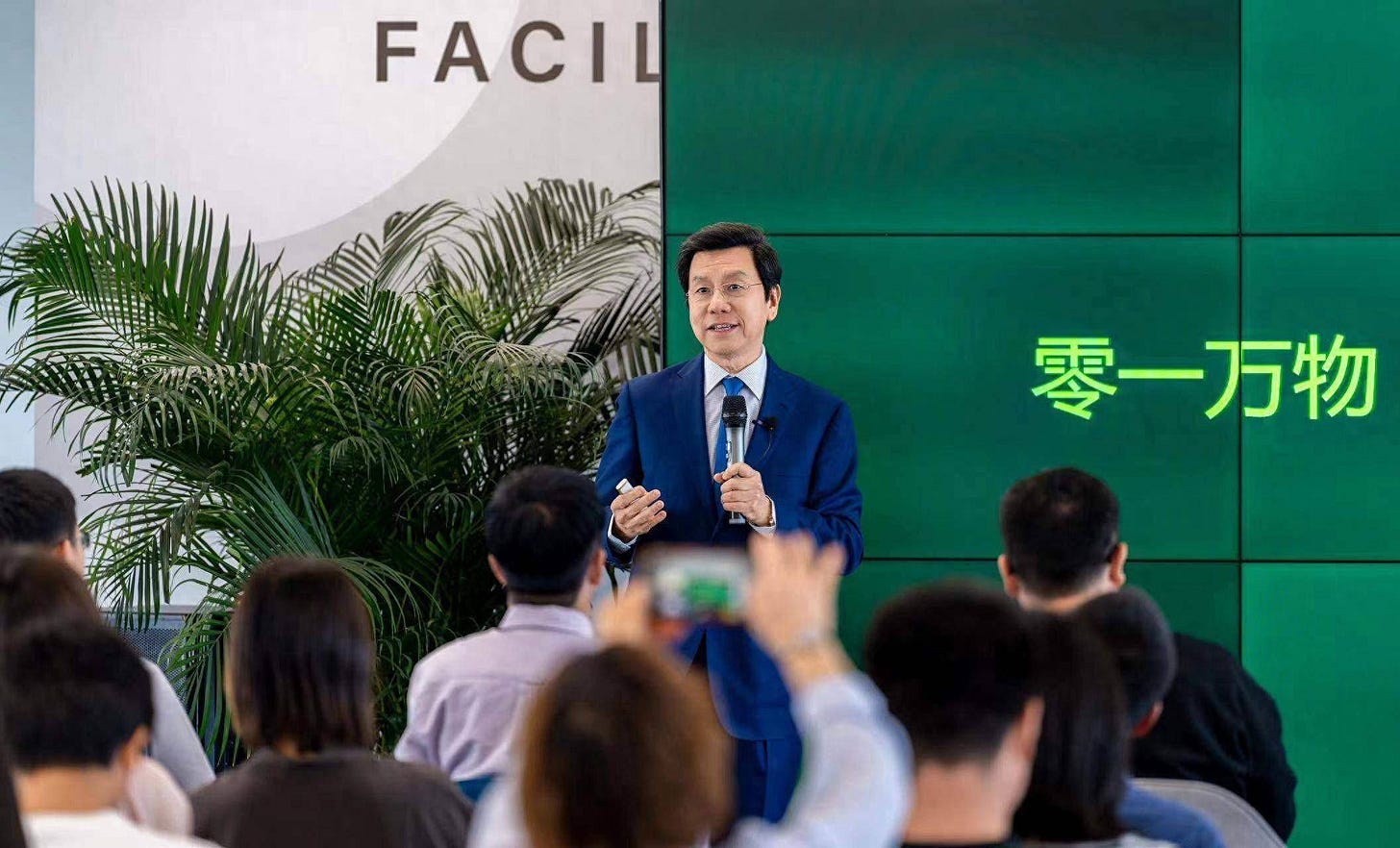🫨Is Pursuing AGI Too Ambitious for Chinese AI Startups?
Lee Kai-Fu said his AI startup 01.AI will stop training LLMs. Parts of the team will be joining Alibaba.
Hi, this is Tony! Welcome to this issue of Recode China AI (for the week of January 6, 2025), your go-to newsletter for the latest AI news and research in China.
What’s new this week? In just the first seven days of 2025, Lee Kai-Fu, the former Google China chief and co-founder of Sinovation Ventures, announced a joint LLM lab between his AI startup 01.AI and Alibaba, dismissed rumors that 01.AI was selling its assets, and later confirmed that parts of the startup would join Alibaba.
Most of 01.AI’s AI training and infrastructure team will transition to this joint LLM lab, while 01.AI will focus on developing lighter LLMs and commercial applications, Lee said.
The whirlwind announcements could mark a turning point for Chinese AI startups, which are struggling to compete with U.S. startups like OpenAI and Anthropic as well as China’s tech giants amid soaring costs, limited funding opportunities, and restricted chip access.
01.AI’s Journey So Far
Founded in May 2023, 01.AI was one of China’s fastest-growing AI startups. It raised $300 million from Alibaba and other investors at a $1 billion valuation, three months after its public unveiling. The company kept churning out competitive models, such as Yi-Large, a 100B-parameter model claiming to outperform GPT-4 across multiple benchmarks, and Yi-Lightning, which ranked #6 on the LMSys leaderboard.
In terms of products, 01.AI is betting on PopAI, an AI-powered document chatbot targeting global markets. Additionally, the company is developing enterprise solutions, including digital humans, to expand its offerings and tap into high-value business use cases. Lee said 01.AI earned RMB 100 million in 2024.
However, its early success was marred by controversy when its flagship model, Yi-34B, was accused of using Meta’s LLaMA 2 architecture without proper attribution. The startup’s subsequent fundraising wasn’t smooth. In August 2024, it managed to raise an undisclosed sum in the hundreds of millions, but it withheld its valuation.
Adding to its challenges, the company struggled with talent retention, losing key figures such as algorithm VP Huang Wenhao and former manager and board member Li Xiangang, both of whom departed for rival firms.
The Rational Behind the Move
The decision wasn’t an easy one for Lee and 01.AI, but the rationale is straightforward: China doesn’t need many companies pre-training LLMs.
AI startups face astronomical bills, not just for chips or renting servers, but also for retaining top-tier talent. Lee explained that in China, only tech giants like Alibaba can sustain the resources to train ultra-scale models capable of advancing AGI. (You can find his interview with Chinese media LatePost here).
The partnership with Alibaba provides a lifeline. By joining forces, 01.AI will avoid the hefty computational costs – over $100 million for GPT-4 and $500 million for next-gen frontier models like GPT-5. In return, Alibaba could maximize its investment returns by gaining top talents and know-how through its partnership with 01.AI, according to Chinese media.
The U.S. has already seen a few acquihires – a type of acquisitions to gain a company’s employees – as tech giants absorb AI startups while dodging regulatory scrutiny. For instance, Google last year paid $2.7 billion to acquire Character.AI’s technology and hired co-founders, Noam Shazeer and Daniel De Freitas, along with about 20% of the startup’s staff. Microsoft paid ~$653 million in total in a deal with Inflection AI, and hired two of Inflection’s three founders, including Mustafa Suleyman, who now leads Microsoft’s consumer AI.
China's anti-monopoly regulations could further complicate acquisitions of AI startups. Allen Zhu, a high-profile Chinese venture capitalist known for investing in Didi Chuxing and Xiaohongshu, said he will not bet chips on AI startups. “With anti-monopoly regulations in place, I don’t know how to exit.”
The big picture is scaling law, which describes how neural network performance changes as key factors are scaled up or down, appears to be slowing earlier than expected. While OpenAI’s GPT-5 has reportedly shown improvements in internal testing, Lee said that the gains may not justify the massive costs for training and long latency during inference. For OpenAI, such investments are still essential in its pursuit of AGI, but for smaller startups, this is far from cost-effective.
A smarter strategy for startups is to collaborate with tech giants and focus on developing lighter models using the “teacher-student” mode, Lee proposed. In this method, ultra-scale models like GPT-5 or Alibaba’s future LLMs will act as “teachers” and guide the training of smaller, more efficient “student” models tailored for specific applications.
Startups are also facing the well-known “AI’s $600 billion question.” Lee stressed that small AI companies must now prioritize the revenue generated from tech research, gradually narrowing losses and progressing from profitability to sustained commercial success.
Is AGI Too Far-Reached for Chinese Startups
Chinese AI startups are grappling with much lower valuations and fundraising compared to their U.S. counterparts. For instance, Moonshot AI, China’s highest-valued LLM startup, is worth $3.3 billion – pale in comparison to OpenAI’s $157 billion valuation or Anthropic’s recent $60 billion valuation. The escalating costs of training models and limited access to advanced U.S. chips further exacerbate the challenge.
Some Chinese startups, like Zhipu AI and StepFun, are committed to training foundation models. They also received funding from state-backed investment vehicles over the recent months.
But with diminishing returns from training larger models and stiffer competition from tech giants and open-source models, companies must answer critical questions:
How to raise additional capital from the market in 2025 and beyond? How will they monetize their LLMs?
Should they partner with giants to survive, or attempt to differentiate themselves in an increasingly saturated market?
For the latter, what is your advantage or competitive moat in LLM training and products?
01.AI’s pivot is hardly surprising. It’s not the most financially-backed AI startup, its LLMs – despite solid performance – lack clear commercialization paths, and it doesn’t have satellite consumer products like Moonshot’s Kimi or MiniMax’s Talkie. But the decision is a respected one. It reflects an urgent need to adapt to an ever-changing market.
01.AI won’t be the last Chinese startup to abandon its AGI dream, and a brutal elimination round could come earlier than anticipated.
Weekly News Roundup
Alibaba is expanding its AI hardware reach by partnering with Hong Kong’s RayNeo to integrate its Qwen LLMs into RayNeo’s smart glasses. (SCMP)
Alibaba Cloud is partnering with Transsion, Africa's leading smartphone vendor, to integrate its Tongyi Qianwen AI model into Transsion's latest Tecno smartphone. (SCMP)
iQIYI filed a lawsuit against MiniMax for unauthorized use of its copyrighted content in AI model training, seeking compensation and a halt to the infringement. (Pandaily)
China is narrowing the gap with the U.S. in AI research, with Chinese institutions, including Tsinghua University, increasing their presence in major AI conferences, challenging the dominance of American entities like Google. (Nikkei Asia)
The US government is poised to introduce new restrictions on China’s access to advanced AI chips before President Joe Biden’s term ends, aiming to close regulatory loopholes and control the global supply of GPUs essential for AI training. (SCMP)
Trending Research
Do NOT Think That Much for 2+3=? On the Overthinking of o1-Like LLMs
rStar-Math: Small LLMs Can Master Math Reasoning with Self-Evolved Deep Thinking
STAR: Spatial-Temporal Augmentation with Text-to-Video Models for Real-World Video Super-Resolution
Test-time Computing: from System-1 Thinking to System-2 Thinking
Virgo: A Preliminary Exploration on Reproducing o1-like MLLM
2.5 Years in Class: A Multimodal Textbook for Vision-Language Pretraining







